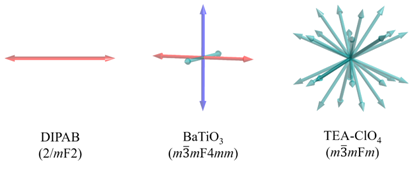报告人:熊仁根 教授
报告人单位:东南大学化学化工学院
报告地点:化一教室
报告时间:2017年12月14日上午8:20
举办单位:多酸科学教育部重点实验室
报告人简介:
熊仁根,东南大学化学化工学院教授,博士生导师。1994年获工学博士学位。1994年在南京大学配位化学研究所博士后研究。1996年在美国Puerto Rico大学从事博士后研究。1997年在美国Brandeis大学从事博士后研究。1998年在美国Boston学院任访问学者。1999-2006年为南京大学化学化工学院教授,博士生导师,南京大学中青年学术骨干。现为东南大学化学东南大学有序物质科学研究中心长江学者特聘教授。现任中国科学B辑-化学、无机化学和中国化学的编委。
报告摘要:
Most conventional inorganic ferroelectrics have more than one equivalent ferroelectric axes, such as BaTiO3 (m3mF4mm) and Pb(Zr,Ti)O3 (m3mF4mm) with three polar axes, BiFeO3 (m3mF3m) with four polar axes. In view of the proprieties of multiple polar axes, inorganic ferroelectrics can be used as polycrystalline state for large-scale application (Figure 1). In contrast to inorganic ones, most molecular ferroelectrics are mono-polar-axis, and the reports on multiple equivalent polar axes are very rare (Figure 1), which severely limits their applications in the polycrystalline state and thin film devices. Based on the molecular and crystal engineering, the Curie symmetry principle and Neumann principle, a series of new molecular ferroelectrics with multiple ferroelectric polar axis have been found. Moreover, we also successfully confirmed the existence of macroscopic ferroelectric in the corresponding polycrystalline films. The introduction of multiaxial nature will lead to a kind of polycrystalline material in the molecular ferroelectrics, molecular ceramic-like ferroelectrics. Such molecular ceramic-like ferroelectrics not only has the characteristics of molecular materials, but also inherits the functionality of inorganic ceramic ferroelectrics that could be applied as polycrystalline state after poling. Combined with the properties of easy-filming, low processing temperature and functionality tunable, it has opened an avenue for the low-cost and large-scale application of molecular ferroelectrics. Once been widely used, it will bring a subversive technological revolution.

Figure 1. The scheme drawing of possible equivalent polarization directions in the three ferroelectrics at room temperature.